When it comes to teaching our children good behavior, you are the role models for our children. They will model what they see us as parents doing. However, a little extra motivation here and there does not hurt. This is where a behavior chart comes in. They make a great tool to help children stay disciplined and behaved. Sometimes they are called “routine charts,” sticker charts,” or “reward charts,” as well. Using these point charts for kids is a good way to modify a behavior in your child that you would like to see changed.
What exactly is a behavior chart?
If there are behaviors that you would like to see change in your child, one of the quickest ways to do it is to use a behavior chart. You should identify one to three behaviors that you want to modify in them. Tackling too many behaviors at once can be overwhelming to your child. Now, you can create the chart itself. A whiteboard can work great for this. However, there are plenty of ideas on Pinterest for behavior charts that you can take cues from! You write down the behaviors that you want your child to modify, and you can denote different symbols to add to the board. For example, if they achieved the desired outcome for the day, you can draw in a star or a smiley face. If not, you can add something like a sad face.

Why use one?
There are key advantages to utilizing behavior charts for toddlers. It will help them quickly turn around the behavior that you are trying to change. It does not require any punishments or time-outs. Children will simply learn that if they perform well on any given day, they will either receive a happy face or a sad face — or whatever you choose to use; some people use stickers. When they reach a certain amount of happy faces or stars, or whatever you choose to use, come up with a reward that they can have. It can be anything you can think of, really. Perhaps an extra half hour of television time, or maybe staying up an extra 10 minutes before bedtime. You can choose that is appropriate for your child. Once your child collects up enough points, they can kind of “cash them in” for the rewards that you have chosen for them. Children will quickly want to rack up as many points as possible, so they will try to turn around their behavior as best as they can.
Don’t forget to praise them
By also praising your child, you will reinforce the good behavior that you are looking for your child to implement. On the same hand, you shouldn’t put them down for not achieving a smiley face or sticker for that day. Negativity will not get you anywhere, but positive reinforcement will help your child along the way of behavior modification. Help them stay the course by reminding them of the reward that they will receive when they behave in the way that you are trying to reinforce. By doing this, they will have extra motivation in order to behave the way that you want them to.

What kinds of behavior charts are there?
There are different “behavior charts” that you can use. It all depends on what you are trying to achieve with your child. For example, if you are trying to start your child with household chores, a behavior chore chart can be implemented. Some easy chores to start them off with is to make sure that they are picking up the toys in their room after playtime is over. Other charts include a chart for homework, but that is less for toddlers and more for children who are in kindergarten and up. You can also create a routine behavior chart. An example of this is, say, that maybe your child has trouble going to bed at night. You can make up a chart that breaks down the routine for them and the individual tasks that they have to do in order to receive a smiley face. If they have to brush their teeth, put on their pajamas, and pick out a book to read, these can be broken down into a chart for them so they can easily see what needs to be done.
There are a variety of behavior charts, and they are an effective parenting tool when it comes to behavior modification in children.
Editors' Recommendations
- What is the Ferber Method, and is sleep training safe for my baby?
- How to help a crying child: Our top tips for sensitive kids
- Can toddlers drink almond milk or other plant-based drinks?
- Flying while pregnant? This is what you need to know
- Is your kid screaming for no reason? Here are ways to deal with a screaming child’s behavior


